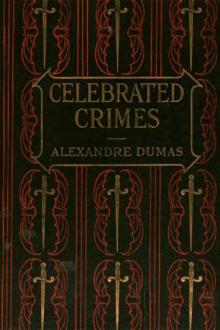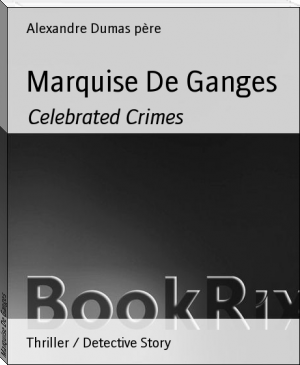The Complete Celebrated Crimes, Alexandre Dumas [good romance books to read TXT] 📗

- Author: Alexandre Dumas
- Performer: -
Book online «The Complete Celebrated Crimes, Alexandre Dumas [good romance books to read TXT] 📗». Author Alexandre Dumas
At this moment the gates opened, and Giacomo appeared first on the threshold. He fell on his knees, adoring the holy crucifix with great devotion. He was completely covered with a large mourning cloak, under which his bare breast was prepared to be torn by the red-hot pincers of the executioner, which were lying ready in a chafing-dish fixed to the cart. Having ascended the vehicle, in which the executioner placed him so as more readily to perform this office, Bernardo came out, and was thus addressed on his appearance by the fiscal of Rome—
“Signor Bernardo Cenci, in the name of our blessed Redeemer, our Holy Father the Pope spares your life; with the sole condition that you accompany your relatives to the scaffold and to their death, and never forget to pray for those with whom you were condemned to die.”
At this unexpected intelligence, a loud murmur of joy spread among the crowd, and the members of the Confraternity immediately untied the small mask which covered the youth’s eyes; for, owing to his tender age, it had been thought proper to conceal the scaffold from his sight.
Then the executioner; having disposed of Giacomo, came down from the cart to take Bernardo; whose pardon being formally communicated to him, he took off his handcuffs, and placed him alongside his brother, covering him up with a magnificent cloak embroidered with gold, for the neck and shoulders of the poor lad had been already bared, as a preliminary to his decapitation. People were surprised to see such a rich cloak in the possession of the executioner, but were told that it was the one given by Beatrice to Marzio to pledge him to the murder of her father, which fell to the executioner as a perquisite after the execution of the assassin. The sight of the great assemblage of people produced such an effect upon the boy that he fainted.
The procession then proceeded to the prison of Corte Savella, marching to the sound of funeral chants. At its gates the sacred crucifix halted for the women to join: they soon appeared, fell on their knees, and worshipped the holy symbol as the others had done. The march to the scaffold was then resumed.
The two female prisoners followed the last row of penitents in single file, veiled to the waist, with the distinction that Lucrezia, as a widow, wore a black veil and high-heeled slippers of the same hue, with bows of ribbon, as was the fashion; whilst Beatrice, as a young unmarried girl, wore a silk flat cap to match her corsage, with a plush hood, which fell over her shoulders and covered her violet frock; white slippers with high heels, ornamented with gold rosettes and cherry-coloured fringe. The arms of both were untrammelled, except far a thin slack cord which left their hands free to carry a crucifix and a handkerchief.
During the night a lofty scaffold had been erected on the bridge of Sant’ Angelo, and the plank and block were placed thereon. Above the block was hung, from a large cross beam, a ponderous axe, which, guided by two grooves, fell with its whole weight at the touch of a spring.
In this formation the procession wended its way towards the bridge of Sant’ Angela. Lucrezia, the more broken down of the two, wept bitterly; but Beatrice was firm and unmoved. On arriving at the open space before the bridge, the women were led into a chapel, where they were shortly joined by Giacomo and Bernardo; they remained together for a few moments, when the brothers were led away to the scaffold, although one was to be executed last, and the other was pardoned. But when they had mounted the platform, Bernardo fainted a second time; and as the executioner was approaching to his assistance, some of the crowd, supposing that his object was to decapitate him, cried loudly, “He is pardoned!” The executioner reassured them by seating Bernardo near the block, Giacomo kneeling on the other side.
Then the executioner descended, entered tie chapel, and reappeared leading Lucrezia, who was the first to suffer. At the foot of the scaffold he tied her hands behind her back, tore open the top of her corsage so as to uncover her shoulders, gave her the crucifix to kiss, and led her to the step ladder, which she ascended with great difficulty, on account of her extreme stoutness; then, on her reaching the platform, he removed the veil which covered her head. On this exposure of her features to the immense crowd, Lucrezia shuddered from head to foot; then, her eyes full of tears, she cried with a loud voice—
“O my God, have mercy upon me; and do you, brethren, pray for my soul!”
Having uttered these words, not knowing what was required of her, she turned to Alessandro, the chief executioner, and asked what she was to do; he told her to bestride the plank and lie prone upon it; which she did with great trouble and timidity; but as she was unable, on account of the fullness of her bust, to lay her neck upon the block, this had to be raised by placing a billet of wood underneath it; all this time the poor woman, suffering even more from shame than from fear, was kept in suspense; at length, when she was properly adjusted, the executioner touched. the spring, the knife fell, and the decapitated head, falling on the platform of the scaffold, bounded two or three times in the air, to the general horror; the executioner then seized it, showed it to the multitude, and wrapping it in black taffetas, placed it with the body on a bier at the foot of the scaffold.
Whilst arrangements were being made for the decapitation of Beatrice, several stands, full of spectators, broke down; some people were killed by this accident, and still more lamed and injured.
The machine being now rearranged and washed, the executioner returned to the chapel to take charge of Beatrice, who, on seeing the sacred crucifix, said some prayers for her soul, and on her hands being tied, cried out, “God grant that you be binding this body unto corruption, and loosing this soul unto life eternal!” She then arose, proceeded to the platform, where she devoutly kissed the stigmata; then leaving her slippers at the foot of the scaffold, she nimbly ascended the ladder, and instructed beforehand, promptly lay down on the plank, without exposing her naked shoulders. But her precautions to shorten the bitterness of death were of no avail, for the pope, knowing her impetuous disposition, and fearing lest she might be led into the commission of some sin between absolution and death, had given orders that the moment Beatrice was extended on the scaffold a signal gun should be fired from the castle of Sant’ Angelo; which was done, to the great astonishment of everybody, including Beatrice herself, who, not expecting this explosion, raised herself almost upright; the pope meanwhile, who was praying at Monte Cavallo, gave her absolution ‘in articulo mortis’. About five minutes thus passed, during which the sufferer waited with her head replaced on the block; at length, when the executioner judged that the absolution had been given, he released the spring, and the axe fell.
A gruesome sight was then afforded: whilst the head bounced away on one side of the block, on the other the body rose erect, as if about to step backwards; the executioner exhibited the head, and disposed of it and the body as before. He wished to place Beatrice’s body with that of her stepmother, but the brotherhood of Mercy took it out of his hands, and as one of them was attempting to lay it on the bier, it slipped from him and fell from the scaffold to the ground below; the dress being partially torn from the body, which was so besmeared with dust and blood that much time was occupied in washing it. Poor Bernardo was so overcome by this horrible scene that he swooned away for the third time, and it was necessary to revive him with stimulants to witness the fate of his elder brother.
The turn of Giacomo at length arrived: he had witnessed the death of his stepmother and his sister, and his clothes were covered with their blood; the executioner approached him and tore off his cloak, exposing his bare breast covered with the wounds caused by the grip of red-hot pincers; in this state, and half-naked, he rose to his feet, and turning to his brother, said—
“Bernardo, if in my examination I have compromised and accused you, I have done so falsely, and although I have already disavowed this declaration, I repeat, at the moment of appearing before God, that you are innocent, and that it is a cruel abuse of justice to compel you to witness this frightful spectacle.”
The executioner then made him kneel down, bound his legs to one of the beams erected on the scaffold, and having bandaged his eyes, shattered his head with a blow of his mallet; then, in the sight of all, he hacked his body into four quarters. The official party then left, taking with them Bernardo, who, being in a state of high fever, was bled and put to bed.
The corpses of the two ladies were laid out each on its bier under the statue of St. Paul, at the foot of the bridge, with four torches of white wax, which burned till four o’clock in the afternoon; then, along with the remains of Giacomo, they were taken to the church of San Giovanni Decollato; finally, about nine in the evening, the body of Beatrice, covered with flowers, and attired in the dress worn at her execution, was carried to the church of San Pietro in Montorio, with fifty lighted torches, and followed by the brethren of the order of the Stigmata and all the Franciscan monks in Rome; there, agreeably to her wish, it was buried at the foot of the high altar.
The same evening Signora Lucrezia was interred, as she had desired to be, in the church of San Giorgio di Velobre.
All Rome may be said to have been present at this tragedy, carriages, horses, foot people, and cars crowding as it were upon one another. The day was unfortunately so hot, and the sun so scorching, that many persons fainted, others returned home stricken with fever, and some even died during the night, owing to sunstroke from exposure during the three hours occupied by the execution.
The Tuesday following, the 14th of September; being the Feast of the Holy Cross, the brotherhood of San Marcello, by special licence of the pope, set at liberty the unhappy Bernardo Cenci, with the condition of paying within the year two thousand five hundred Roman crowns to the brotherhood of the most Holy Trinity of Pope Sixtus, as may be found to-day recorded in their archives.
Having now seen the tomb, if you desire to form a more vivid impression of the principal actors in this tragedy than can be derived from a narrative, pay a visit to the Barberini Gallery, where you will see, with five other masterpieces by Guido, the portrait of Beatrice, taken, some say the night before her execution, others during her progress to the scaffold; it is the head of a lovely girl, wearing a headdress composed of a turban with a lappet. The hair is of





Comments (0)